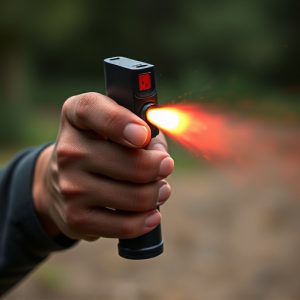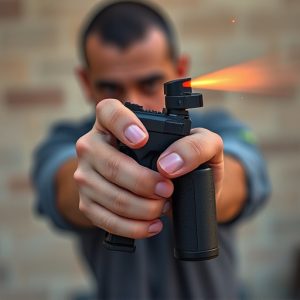Inflammatory Riot Control Spray Dispensers: Effective Spray and Move Tactics
Inflammatory riot control spray dispensers are specialized tools for law enforcement managing civil…….
Inflammatory riot control spray dispensers are specialized tools for law enforcement managing civil unrest. Using "Spray and Move" techniques, officers release targeted bursts of capsaicin irritant to temporarily incapacitate agitators, creating space to regain control. Effective use requires proper training in wind dynamics, crowd behavior, and safe deployment practices to minimize bystander risk while maximizing impact. Safety measures include PPE and strategic retreats post-deployment to prevent counter-attacks. Regular practice enhances riot control teams' expertise in high-pressure scenarios.
“Discover the powerful tool shaping modern riot control tactics: the inflammatory riot control spray dispenser. This innovative device, designed for efficient crowd management, has transformed public safety strategies. In this comprehensive guide, we explore its inner workings, from understanding the technology to mastering crucial deployment techniques like Spray and Move. Learn about key components, safety protocols, and best practices to ensure effective and responsible use in various scenarios. Uncover why this dispenser is a game-changer for law enforcement and security professionals.”
- Understanding Inflammatory Riot Control Spray Dispensers
- Key Features and Components of the Spray Dispenser
- Effective Spray and Move Deployment Techniques
- Safety Measures and Best Practices for Use
Understanding Inflammatory Riot Control Spray Dispensers
Inflammatory riot control spray dispensers are specialized tools designed for law enforcement agencies to manage and disperse crowds during civil unrest or large-scale gatherings. These advanced devices play a crucial role in maintaining public safety by offering non-lethal means of crowd control. Understanding how these sprays work and the deployment techniques involved is essential for both officers and those interested in riot control strategies.
Spray and move deployment is one of the primary methods employed by these dispensers. It involves releasing a targeted stream of irritant spray, often containing capsaicin or similar compounds, into the air. This quick-acting substance temporarily incapacitates individuals, creating space for officers to regain control. The key to effective use lies in proper training and understanding the wind dynamics to ensure the spray reaches its intended targets without endangering bystanders.
Key Features and Components of the Spray Dispenser
The Inflammatory Riot Control Spray Dispenser is a specialized tool designed for law enforcement and security personnel to manage and disperse crowds during volatile situations. Key features include a powerful spray mechanism that releases a precise, targeted stream of irritant chemicals. These dispensers are ergonomically engineered for ease of use, allowing officers to deploy the spray with speed and accuracy while maintaining their own safety.
The components of these devices are strategically designed to facilitate effective spray and move deployment techniques. A robust housing protects internal mechanisms from environmental stressors, ensuring consistent performance under pressure. The trigger mechanism is sensitive yet reliable, enabling quick activation during high-stress scenarios. Additionally, many models offer adjustable settings for different applications, allowing officers to customize the spray’s intensity and range according to the situation’s demands.
Effective Spray and Move Deployment Techniques
In the heat of an inflammatory riot, efficient Spray and Move deployment techniques are crucial for managing chaos and ensuring officer safety. The key lies in a swift, strategic approach—a precise burst of spray to incapacitate agitators, followed by rapid retreat or advancement, depending on the situation’s dynamic. Officers must train extensively to time their movements perfectly with the spray release, allowing them to maintain a safe distance while disrupting the crowd’s momentum. This tactic requires discipline and coordination among team members to avoid causing harm to innocent bystanders or fellow officers.
Effective execution demands an understanding of wind patterns, crowd behavior, and the spray’s range and duration. Officers should aim for face and eyes, temporarily blinding and disorienting individuals without causing lasting damage. Once deployed, a quick retreat is essential to prevent counter-attacks; alternatively, advancing through the dispersed crowd can help restore order. These techniques, when practiced regularly, enable riot control teams to navigate complex situations, demonstrating their proficiency in managing high-pressure scenarios.
Safety Measures and Best Practices for Use
When utilizing an inflammatory riot control spray dispenser, safety should be the paramount concern. It’s crucial to follow best practices to ensure effectiveness and minimize risks. Operators must receive adequate training on proper usage, including understanding the spray’s range, wind conditions, and target selection. Personal protective equipment (PPE), such as eye protection and respirators, is essential to prevent exposure to the spray.
In terms of deployment, the “Spray and Move” technique is a recommended strategy. This involves quickly releasing the spray while simultaneously withdrawing or advancing to maintain distance from targets. It’s important to aim for exposed areas like faces, eyes, and upper body to maximize impact while minimizing collateral damage. Operators should also be aware of environmental factors like fuel sources, as these can significantly affect the spread and intensity of the spray.
Inflammatory riot control spray dispensers, with their unique capabilities, offer a strategic advantage in managing civil unrest. By understanding the key features, deployment techniques like Spray and Move, and adhering to safety best practices, authorities can effectively de-escalate volatile situations. These dispensers play a vital role in public safety, ensuring a swift and controlled response during riots, and are a game-changer for law enforcement agencies worldwide.

